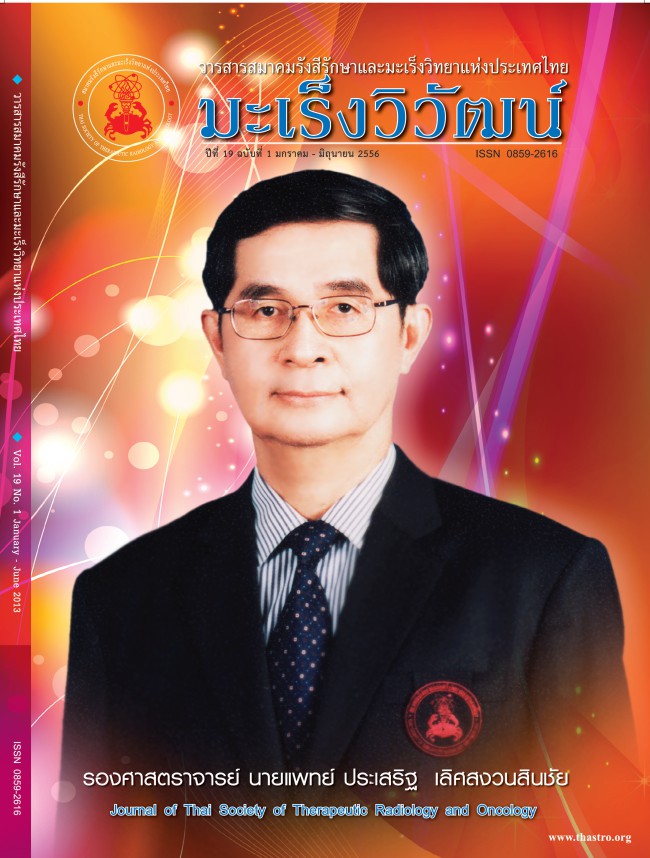เปรียบเทียบปริมาณรังสี ที่ฐานกะโหลกส่วนหน้าและแอ่งสมองส่วนกลาง จากการฉายรังสีแบบคลุมเยื่อหุ้มสมองทั้งหมด โดยใช้จุดศูนย์กลางที่ตำแหน่งต่างกัน
คำสำคัญ:
Dosimetric comparison, whole subarachnoid irradiation, cribriform plate, middle cranial fossaบทคัดย่อ
หลักการและเหตุผล : การฉายรังสีแบบคลุมเยื่อหุ้มสมองทั้งหมดในผู้ป่วยที่มีแนวโน้มจะมีโรคมะเร็งกระจายไป ตามช่องน้ำเลี้ยงไขสันหลัง มีตัวแปรสำคัญของการกลับเป็นซ้ำ และอัตรารอดชีวิตคือ การครอบคลุมขอบเขตมะเร็ง อย่างเพียงพอ ตำแหน่งที่พบว่ามีความคลาดเคลื่อนบ่อยได้แก่ ฐานกะโหลกส่วนหน้า และ แอ่งสมองส่วนกลาง วัตถุประสงค์ : เพื่อเปรียบเทียบความครอบคลุมของปริมาณรังสีที่ cribriform plate และ middle cranial fossa ระหว่างการฉายรังสีป้องกันการลุกลามที่สมองโดยใช้ศูนย์กลางอยู่ที่ขอบกระบอกตาด้านข้างกับกึ่งกลางสมอง วัสดุและวิธีการ : ศึกษาในผู้ป่วยที่ได้รับการทำเอ็กซเรย์คอมพิวเตอร์สมองเพื่อจำลองการฉายรังสีตั้งแต่มกราคม 2554 ถึงกุมภาพันธ์ 2555โดยวางแผนการฉายรังสีแบบ two lateral opposed whole subarachnoid จากภาพ เอ็กซเรย์คอมพิวเตอร์ด้วยศูนย์กลางลำรังสีที่แตกต่างกันคือ กึ่งกลางสมอง (ตำแหน่ง A) สำาหรับแผน A และขอบ กระบอกตาด้านข้าง (ตำแหน่ง B) สำหรับแผน B ด้วย Varian Eclipse treatment planning system version 8.0 จากนั้นประเมินปริมาณรังสีที่ cribriform plate, middle cranial fossa และเลนส์ตาของแต่ละแผน ผลการศึกษา : ผู้ป่วยทั้งสิ้น 44 ราย อายุเฉลี่ย 38 ปี เพศชาย 26 คน (59.1%) เพศหญิง 18 คน (40.9%) วินิจฉัย เป็นโรคเนื้องอกสมองมากที่สุด (63.64%) พบว่าแผน B ทำให้ปริมาณรังสีต่ำสุดของขอบเขตมะเร็งทางคลินิก (clinical target volume) และการวางแผน (planning target volume) เพิ่มขึ้นอย่างมีนัยสำคัญทางสถิติ (p-value =0.001 และ 0.002 ตามลำดับ) ส่วนปริมาณรังสีไปยังเลนส์ตาในแผน B ก็เพิ่มขึ้นจากแผน A 3.6 % ข้อสรุป : การฉายรังสีโดยให้ศูนย์กลางลำรังสีอยู่ที่ขอบกระบอกตาด้านข้างเพื่อป้องกันการลุกลามที่สมองเพิ่ม ความครอบคลุมของปริมาณรังสีต่ำสุดที่สมองได้มากกว่า
References
Gripp S, Doeker R, Glag M, Vogelsang P, Bannach B, Doll T,et al. The role of CT simulation in whole-brain irradiation. Int J Radiat Oncol Biol Phys 1999;45:1081–8.
Andic F, Ors Y, Niang U, Kuzhan A, Dirier A. Dosimetric comparison of conventional helmet - field whole- brain irradiation with three- dimensional conformal radiotherapy : dose homogeneity and retro-orbital area coverage. Br J of radiology 2009;82:118-22.
Kortmann RD, Hess CF, Hoffmann W, Jany R, Bamberg M. Is the standardized helmet technique adequate for irradiation of the brain and the cranial meninges? Int J Radiat Oncol Biol Phys 1995;32:241-4.
Weiss E, Krebeck M, Ko¨hler B, Pradier O, Hess CF. Does the standardized helmet technique lead to adequate coverage of the cribriform plate? An analysis of current practice with respect to the ICRU 50 report. Int J Radiat Oncol Biol Phys 2001;49:1475-80.
Grabenbauer GG, Beck JD, Erhardt J, Seegenschmiedt MH, Seyer H, Thierauf P, et al. Postoperative radiatiotherapy of medulloblastoma. Am J Clin Oncol 1996;19:73-7.
Miralbell R, Bleher A, Huguenin P, Ries G, Kann R, Mirimanoff RO, et al. Pediatric medulloblastoma:Radiation treatment technique and patterns of failure. Int J Radiat Oncol Biol Phys 1997;37:523–9.
Carrie C, Alapetite C, Mere P, Aimard L, Pons A, Kolodie H, et al .Quality control of radiotherapeutic treatment of medulloblastoma in a multicentric study: The contribution of radiotherapy technique to tumour relapse. Radiother Oncol 1992; 24:77– 81.
Downloads
เผยแพร่แล้ว
How to Cite
ฉบับ
บท
License
บทความที่ได้รับการตีพิมพ์เป็นลิขสิทธิ์ของวารสารมะเร็งวิวัฒน์ ข้อความที่ปรากฏในบทความแต่ละเรื่องในวารสารวิชาการเล่มนี้เป็นความคิดเห็นส่วนตัวของผู้เขียนแต่ละท่านไม่เกี่ยวข้องกับ และบุคคลากรท่านอื่น ๆ ใน สมาคมฯ แต่อย่างใด ความรับผิดชอบองค์ประกอบทั้งหมดของบทความแต่ละเรื่องเป็นของผู้เขียนแต่ละท่าน หากมีความผิดพลาดใดๆ ผู้เขียนแต่ละท่านจะรับผิดชอบบทความของตนเองแต่ผู้เดียว



